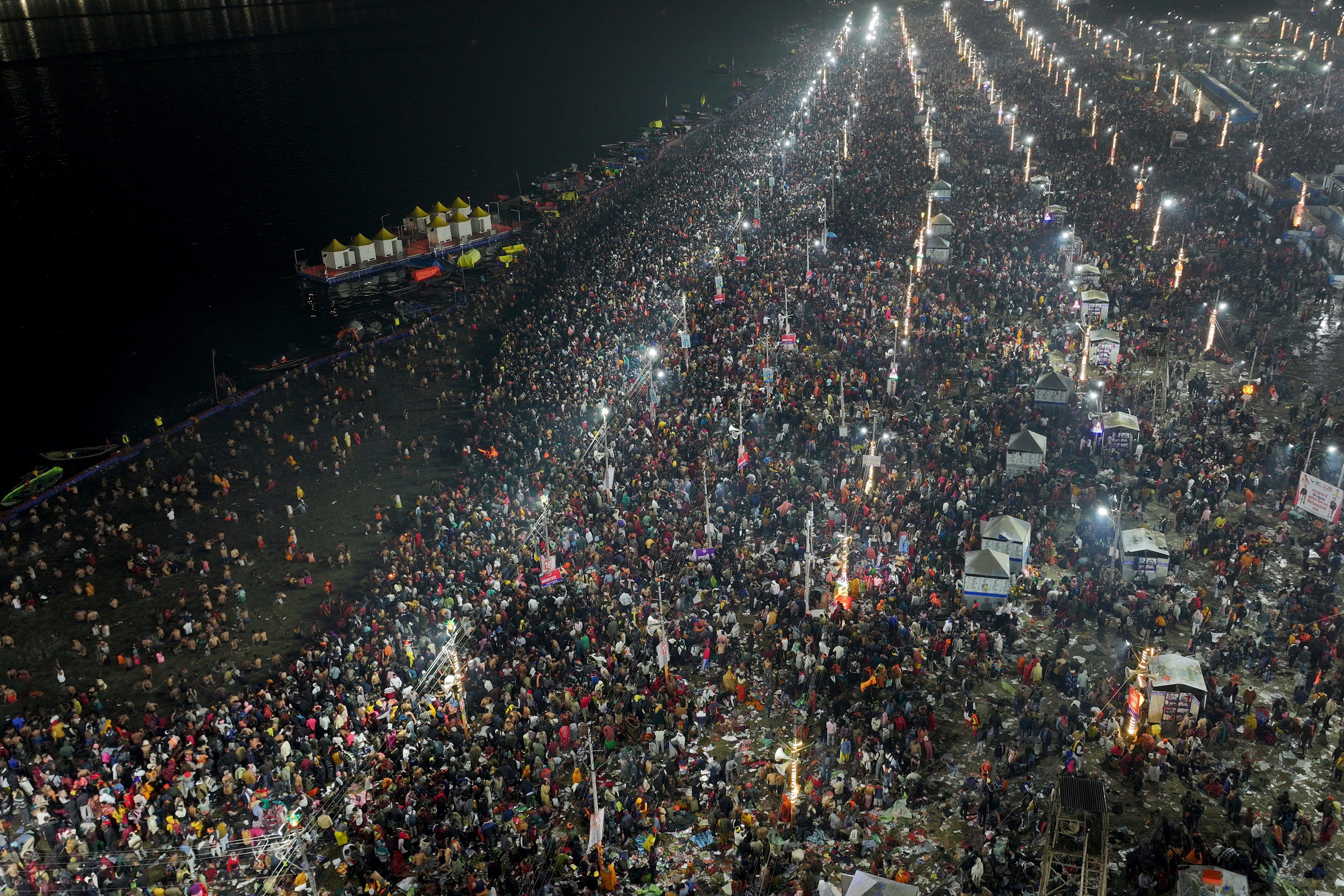The pilgrims came, millions upon millions, in an unrelenting tide, forming one of the largest religious gatherings in history. Day after day, the crowd – drawn by faith – swelled and pressed closely together, seeking purification in the sacred waters of the Ganga. They made their way through a sea of people, treading carefully down the slope before reaching the riverbank. At times they leaned on bystanders to steady themselves, other times they threatened to trample those around them. And then, it happened.
In the small hours of Wednesday, tragedy struck the Maha Kumbh Mela in India’s Prayagraj. A stampede near the Sangam Ghat before dawn killed at least 30 people and left 60 injured, with the death toll expected to rise further.
The Maha Kumbh is a Hindu religious festival that is held once every 12 years at the confluence of the Ganga and Yamuna rivers in the northern state of Uttar Pradesh.
Its origin lies in the Hindu lore that the gods spilled four drops of the nectar of immortality on Earth and, when the Moon and Jupiter align, the Ganga and the Yamuna are joined by a mystical river called Saraswati, meeting at the points where the divine nectar fell.
Any Hindu who takes a dip in the conjoined waters during this time is cleansed of their sins and receives blessings that last for generations, pilgrims at the festival tell The Independent.
They make the trip not just for themselves but for their children and grandchildren.
On this occasion, though, dozens of pilgrims lost their lives as the festival descended into chaos on one of its busiest and holiest days – Mauni Amavasya, or the New Moon day.
For many who were there in the days leading up to this week, it feels like it was a disaster waiting to happen.

The seeds of Wednesday’s tragedy were planted days ago when the Uttar Pradesh police and the Kumbh administration blocked several pontoon bridges for the movement of VIP vehicles. Throughout the festival, politicians and celebrities are afforded opportunities to bathe privately – creating traffic jams and even more cramped conditions for millions of ordinary pilgrims who have to walk miles along narrow pathways.
On 25 January, The Independent came across multiple barricades on different routes to the Kumbh Mela, with seemingly overwhelmed police personnel working to reroute the one-way traffic jam on a narrow road.
“Yogi ji is here. So, we are rerouting,” a police officer explains, referring to Uttar Pradesh chief minister Yogi Adityanath.
At pontoon bridge 17, close to Sangam, as the confluence of the rivers is known, several routes for vehicular movement were shut for hours on end. “It will open once Yogi ji leaves,” two police personnel manning the barricade confirm. “No vehicles are allowed on the bridge till then.”
To compound the chaos, roads were often suddenly closed without explanation. Serpentine queues of vehicles were everywhere, with even special commandos riding military-issue vehicles becoming stuck.

As dusk fell on Tuesday, loudspeakers announced the start of Mauni Amavasya, drawing even more devotees towards Sangam. Seasoned pilgrims knew the ideal time for the ritual bath was at dawn, so many of them chose to rest by the ghats, planning to take a dip at sunrise and leave quickly afterwards.
At around 1.30am, there was a massive influx of new pilgrims.
The police forcefully herded them down a narrow path leading to Sangam despite several pontoon bridges offering a better route to regulate this rush, eyewitnesses tell The Independent.
“It was so crowded I felt I would die of suffocation,” Somi Devi, 67, tells The Independent. “I didn’t understand what was happening.”
Chaos ensued as the crowd surged forward. In a desperate attempt to escape the crush, some people climbed poles, which reportedly collapsed.
“I survived this only because of the blessings of Goddess Ganga,” Devi says. The stampede did not deter her from going ahead with her pilgrimage and taking the “holy dip” herself.

The Kumbh has seen stampedes before, in 1840, 1906, 1954 and 1986, according to The New York Times. On the same day of the last Maha Kumbh, 12 years ago, a stampede at the local train station to the festival killed 36 people, and forced the resignation of the organising committee chief.
Measures are put in place to prevent such tragedies from occurring – yet they have been found wanting, time after time.
In the weeks before tragedy struck on Wednesday, the Hindu nationalist government of Narendra Modi in Delhi and of Yogi Adityanath at the Uttar Pradesh state level had been touting the scale of the preparations for the festival, which serves as a powerful display of India’s religious soft power.
In the course of the 45-day festival, some 400 million people are expected to take part in the Maha Kumbh, a staggering number that dwarfs the two million pilgrims who journeyed to Saudi Arabia for the annual Hajj pilgrimage last year.
The festival has attracted several prominent figures this year, such as Indian federal ministers Rajnath Singh and Amit Shah, and Chris Martin of the band Coldplay.
The pilgrimage site has been turned into a sprawling tent city, stretching over 40sq km along the riverbanks and divided into 25 sections to provide smoother management. There are over 3,000 kitchens, 150,000 toilets and 11 hospitals.
Indian Railways is running more than 90 special trains, making nearly 3,300 trips to transport the devotees, in addition to its regular services.
The state government of Adityanath has allocated over $765m for this year’s festival.
Prayagraj is filled with towering billboards and posters of Adityanath and Modi, underscoring the political aspect of the event as the ruling Hindu nationalist Bharatiya Janata Party (BJP) seeks to leverage the festival to strengthen its influence.

In spite of the money spent and the scale of preparations, the pilgrims don’t have much to sustain themselves apart from their faith. Earlier this week, prior to the tragic events of Wednesday, they sounded cheerful and accepting of the discomforts of the festival, and humbled by the chance to take their holy dip.
Shri Shivkumari, a 65-year-old with a heart ailment, had been living in a tent on the riverbank for more than two weeks since 10 January. When The Independent meets her she is yet to reach Sangam, despite having walked for over two hours from the other end of the festival site.
But that doesn’t dampen her spirits. “Mother Ganga blesses you with a lot of peace and happiness. Grants wisdom and intelligence. Children live happily,” she says.
As she walks across a pontoon bridge on the river with her son and daughter-in-law, tying garlands on the railing, Shivkumari sings in a regional dialect: “Help us cross the river on your boat. Take me to the other side, O ferryman! Take me to the Ganga, ferryman. I want to worship the holy Ganga.”
Ramlal Yadav, 52, has travelled nearly 300km from Gorakhpur in eastern Uttar Pradesh to be at the Kumbh. He’s still figuring out the practicalities of securing two tents for the 26 people accompanying him, at a cost of Rs 10,000 (about £93) for six days.
Two lines of blue tents stand on bare land, fluttering in the wind, held in place by a pole through the middle and nails at the four edges. There’s not much in terms of privacy, as the tent can’t be zipped or tied. Several pairs of slippers are scattered outside each tent, often occupied by 10 people. Seeing a tent assigned to his group, Yadav is elated.
“There is a toilet and a bathroom. And our mother Ganga is closer to us. There is water. What more do we want?” he says. “Having seen the goddess Ganga, I want nothing else.”
Anju Dikshit, 56, is equally ecstatic to be at the Kumbh Mela. She has travelled 600km from the central state of Chhattisgarh. “I am not here to take advantage of the facilities. We have come here to celebrate Kumbh.”
Sat at the festival are Meena Mishra and her husband. She is reading a prayer book while her husband makes a run to arrange food from the nearest free community kitchen. “What is wrong in this? Everything is here. Our Ganga is here, water and food is there. We don’t need much else,” she says.

The streets even after 8pm are far from quiet. Apart from the hustle and bustle of the crowd, announcements over speakers and street vendors screaming at the top of their voices and preachers giving sermons create a cacophony.
The sermons are delivered by preachers sitting on stages and accompanied by musicians and singers.
One preacher explains why the Lord was born, recounts the number of avatars the Lord has had, and then breaks into a religious song praising Lord Rama.
“Pick up the 18 Puranas, Upanishads and Vedas. And start asking, ‘Who is God? Why is He?’ You will spend your whole life trying to understand this. You will end but the stories of God will never end,” he says, as a musician plays the synthesiser, apparently seeking to complement the seriousness of the question.
Among the listeners is Trojan Hendrickson, 35, who has travelled from Australia after hearing so much about the highly publicised religious festival.
“I want to experience Kumbh for the feeling,” he tells The Independent, adding that he doesn’t quite know what drew him to the festival. “I want to meet all the babas and all the Indian locals. I heard it’s the biggest festival in the world, so I wanted to experience it.”

A popular attraction at the festival is the Kinnar Akhada, a congregation of transgender saints. Transgender people have had a place in religious and spiritual traditions of India going back centuries, explains Devyani Mukherjee, a trans woman, as she gives blessings to believers.
“It is believed that wherever we trans stand that place is filled with positivity. It is to seek for this positivity that people come to us,” says the former activist and model.
For many transgender people in the Akhada, the Kumbh is a spiritual calling as well as a platform to reclaim their religious identity.
Mukherjee says she has always been religious, having been guided into this path by her guru, who understood her struggles and took her under his wing.
Indu Nandgiri, another Kinnar Akhada member, emphasises that their blessings are sought for health, prosperity and long life as she partakes in a unique tradition of giving a one-rupee coin.
“It represents goddess Lakshmi and symbolises abundance,” explains Nandgiri, a former IT professional. “The coin, when received as a blessing, is believed to ensure that food and wealth never leave a devotee’s home.”
This is the tragic irony of Wednesday’s disaster – that it affected so many pilgrims who had travelled seeking nothing more than a blessing for a long life, and the washing away of sins.
Jaiprakash Singh, 64, from Ayodhya is sitting on a plastic sheet in the open, covering himself with a blanket, near the confluence. “I eat sparingly to avoid frequent trips to the public toilets,” he says. “What is more important than God’s blessing? It is enough for us.” Having already spent a night in the open, he plans to stay another. A couple of days later, pilgrims like him who were resting along the riverbanks were among those trampled during the crush.
Despite Wednesday’s events, the festival will continue, with another particularly auspicious day in the celestial calendar falling on Monday 3 February. The authorities at Kumbh have promised to learn from the events of this week, and say there will be no VIP access in the coming days. Changes have already been made to how the flows of crowds are managed.
Adityanath has ordered a judicial inquiry – though he also played down the severity of the disaster on Wednesday, and it took officials more than 16 hours to admit there had been any fatalities at all.
For families mourning the loss of loved ones, excitement at the trip of a lifetime has turned into demands for accountability. Saroja, a pilgrim from the southern city of Belagavi who lost four family members in the stampede, must now accompany them home on a repatriation flight to Karnataka. “Police didn’t make proper arrangements,” she tells Reuters. “They are responsible for this.”







